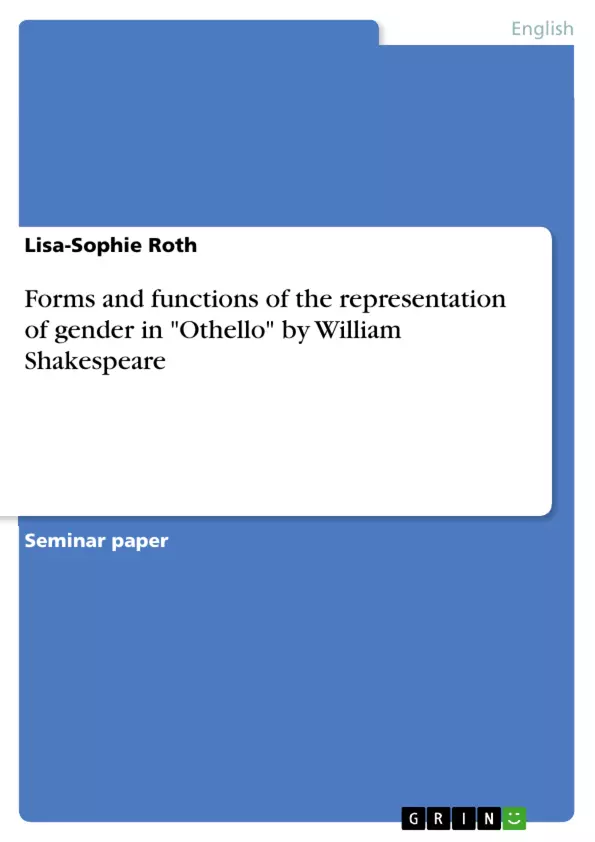The paper discusses the forms and functions of the representation of gender in William Shakespeare’s "Othello".
Beginning with an overview of gender stereotypes and social hierarchies in Shakespeare’s times, referencing mainly Susan Almussen’s "Gender, Culture and Politics in England", as well as Stephen Orgel’s "Shakespeare, sexuality and gender", the uncovered results shall then be referred to the gender representation in the play at hand. Given the patriarchy present in early modern ages, the author will examine in how far this patriarchy is presented in Othello and how the female characters behave or should behave according to it. One of the male characters, Iago, stands behind most of the dramatic actions of the play – Using Prof Dr Heinz Antor’s "Constructing Alterity: Race, Gender, and the Body in Shakespeare’s Othello", the next chapter has the aim to examine the motivations behind his mischievous plans and how and against whom he performs them. Then the author is going to answer where the differences between male and female friendships lie and how they are characterized throughout the play. The last chapter mainly refers to Emily C. Bartels’ "Strategies of Submission: Desdemona, the Duchess, and the Assertion of Desire", and tends to find out if and how the female characters revolt against the patriarchal society they live in and which does not give them much room to criticize or even revolt against the social hierarchies.
Table of Contents
- Introduction
- Gender relations and stereotypes in early modern England
- Representation of male-female relationships in Shakespeare's Othello
- Women as men's possession
- Submissive women in the patriarchy
- Misogynist manipulation - Iago's mischievous plan.
- The world turned upside down? Of jealous, lying men and loyal women.
- Revolt against the patriarchy – women who defend themselves......
- Conclusion
Objectives and Key Themes
This term paper examines the representation of gender in William Shakespeare's Othello. It analyzes the forms and functions of gender representation in the play, considering the context of early modern England and the play's reception in modern times. The paper focuses on the portrayal of male and female characters, their interactions, and the extent to which they conform to or challenge early modern gender stereotypes. It also investigates the motivations behind Iago's actions and the role of male-female relationships in the play's dramatic events.
- Gender stereotypes and social hierarchies in early modern England
- Representation of male and female characters in Othello
- The role of Iago and his motivations
- The dynamics of male-female relationships in the play
- The potential for female characters to challenge patriarchal structures
Chapter Summaries
The introduction provides an overview of the play's popularity and the enduring relevance of its themes, including race, love, and gender. It outlines the paper's focus on the representation of gender in Othello and the key questions that will be explored. Chapter 2 examines the social context of early modern England, focusing on the gender stereotypes prevalent at the time. It highlights the perceived differences between men and women, the patriarchal system, and the expectations placed on women regarding their chastity and intellectual capabilities. Chapter 3 investigates the representation of male-female relationships in Othello, analyzing how these relationships are portrayed in the play and the extent to which they conform to or subvert the expectations of early modern gender norms. Chapter 4 focuses on Iago, exploring his motivations and the nature of his manipulative plans. It examines how Iago's actions contribute to the play's dramatic tension and how he manipulates others to achieve his goals.
Keywords
The primary keywords and focus topics of this term paper include gender representation, early modern England, Shakespeare, Othello, patriarchy, gender stereotypes, male-female relationships, Iago, manipulation, and female agency.
- Quote paper
- Lisa-Sophie Roth (Author), 2018, Forms and functions of the representation of gender in "Othello" by William Shakespeare, Munich, GRIN Verlag, https://www.grin.com/document/903496



